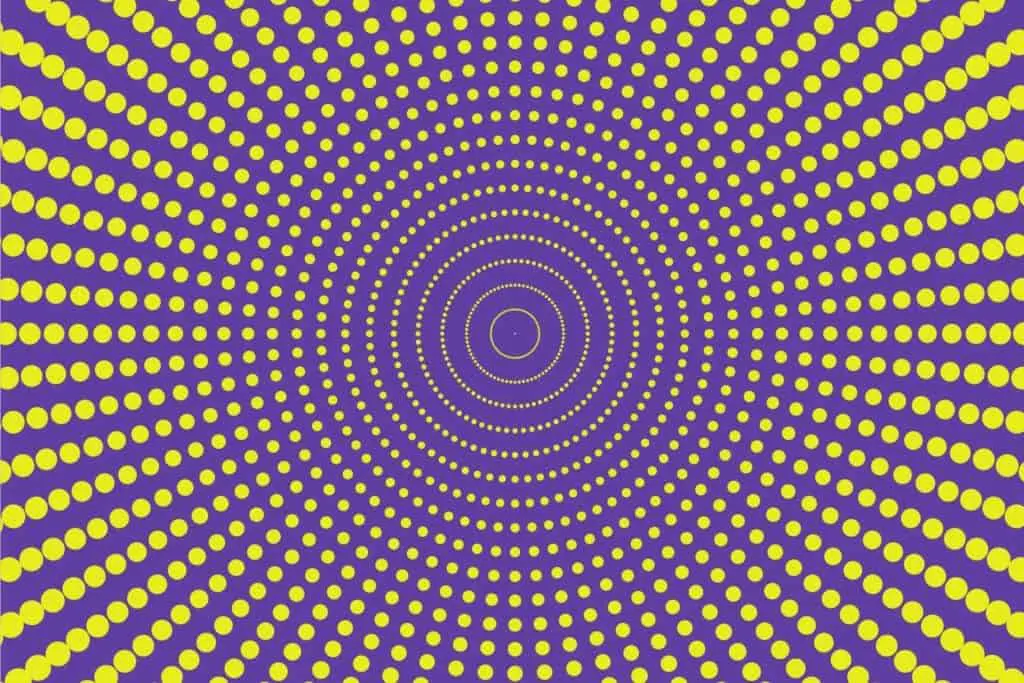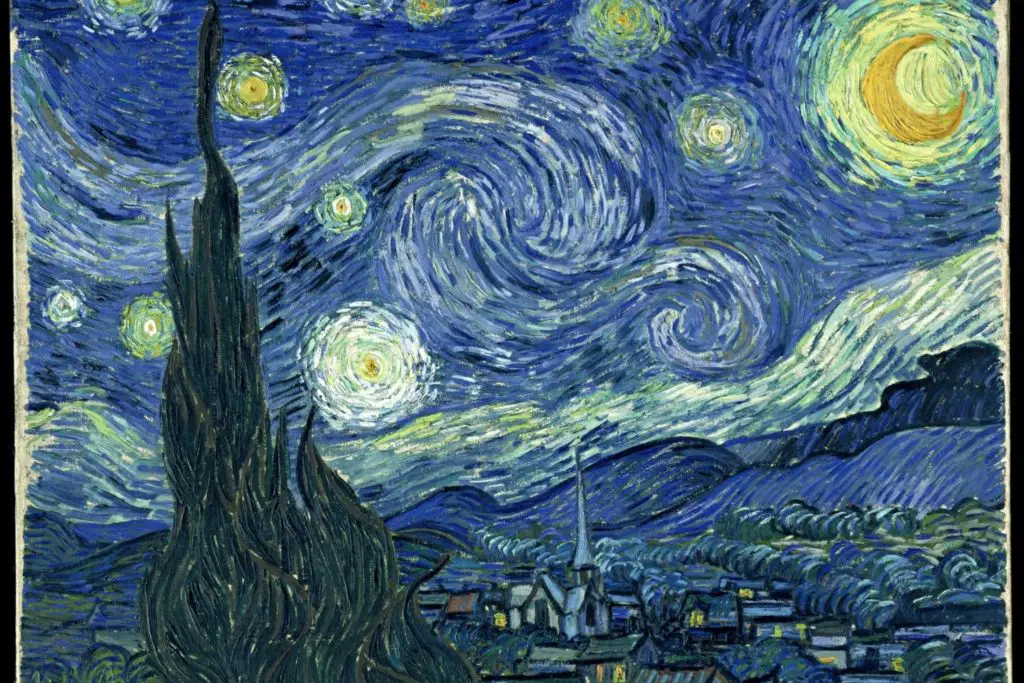Is Starry Night by Van Gogh a Good Example of Movement for the Princples of Art
Move in fine art is one of the principles which makes an artwork interesting.
Drawing or painting is a static artwork composed of vii or lesser fine art elements, and it sometimes creates boredom equally it is stationary. Artists create an impression of movement using principles of art to brand it lively.
Motion is a principle used by artists that guide the viewer's eye to move from 1 function of the artwork. It tin can also create an illusion that the resultant painting, although stationary, depicts motility or sometimes looks like information technology is moving.
An artist tin as well create the field of study or object that looks moving, like a person running or an apple falling, and it expresses that the motion picture has some movement in it.
The viewer'south eye offset looks at the focal point and and then moves into a different area of the artwork based on the motility techniques used by the artist in the composition.
An artist creates the motion using shapes, colors, edges, and lines.
What is movement in the Principles of Art?
While Elements of Art are the tools used to construct an artwork, Principles of Art give a framework or guidance on using those tools.
Movement is one of the principles of art, and it gives life to artwork by cartoon and pushing attention from i office of the painting to another.
When a person sees an artwork, his eyes ordinarily roam over the painting. Artists consciously use various elements and principles to motion the attention to multiple parts of the moving-picture show visually.
The 8 Principles of Arts are listed below:
- Rest
- Proportion
- Unity
- Harmony
- Variety
- Emphasis
- Rhythm
- Movement
An artist cannot create movement principles alone in isolation, and it works with other principles like rhythm and line, color, shapes, etc., to piece of work cohesively.
What is Motion in Art?
An impression created in the artwork which depicts activity or motion is called Movement in Art.
The artwork which nosotros create is motionless and cannot motion. Just we can make it so that information technology gives the viewers the impression that it is moving.
An artist creates an impression of movement in his artwork by arranging the elements of art.
The arrangement of Brushstrokes in such a way can create motion in art.
What are some of the techniques to show movement in art?
How do Line show movement in art?
The line, even though it is a static image, can depict motion in an artwork.
A straight and vertical line creates an illusion that the line is property to the ground. A horizontal line gives an impression of resting on the ground without any movement.
A slanting line gives an illusion that information technology is most to fall, creating an illusion of movement. A edifice that is cartoon slanting will make an impression that it is falling.
Curvy lines evidence weakness.
Lines and motility go hand in paw. Abstruse artists can create movement using lines by cartoon them quickly or slowly to form different shapes and patterns.
For case, Andrew Loomis' artwork depicts motility using parallel lines extending from i side of the canvas to the other.
What is Rhythm and Motility in art?
Rhythm in art is the regular placement of elements in artwork composition, and they are like beats in music similar 1,0,one,0,1,0.
In that location are 5 types of Rhythm: Regular Rhythm, Alternate Rhythm, Flowing Rhythm, Progressive Rhythm, and Random Rhythm.
Except for the Random Rhythm, at that place is some predictable placement of elements in other types of Rhythm then the person viewing can predict the future, thereby guiding the eyes to follow through.
On the other paw, movement is how your eyes movement on an artwork, and Rhythm guides the viewer'south middle in moving from one role of the artwork to another.
In other words, we can say the movement is a resultant of Rhythm.
Movement is an action, and Rhythm is more like a design.
An artist can create Movements using lines, shapes, colors, edges every bit they are similar to Rhythm.
Both Movement and Rhythm are the principles of art.
What is illusion of motility in fine art?
Optical art, also called Op Fine art, is an art that exhibits optical illusion. Ane can use the Art elements to create the illusion or brand our brains believe that the motion picture objects are moving.
Observing the center dot in the below picture creates an illusion that some line is moving on both sides, and it is a kind of optical illusion, even though at that place is no physical move.

These are more often than not abstract arts and are drawings made on Geometric designs.
You can brand this by creating concentric circles, parallel lines, or other geometric figures, or some method using colors.
When the viewer observes this kind of artwork, his eyes attempt to understand and justify it as right or incorrect and seeking reason, and his eyes quickly proceed moving around the art.
This upshot creates an illusion that the drawing is moving.
Departure between Art movements and movements in Fine art?
Art movements and movements in art are two different concepts. Art motility refers to a style of art during a menstruum, whereas motion in fine art refers to the principle of art used by an artist.
What is Art movement?
Fine art motility refers to a style of art created or followed by a group during a specific period. The move will take certain logic, objects, or goals.
There are several fine art movements, and to listing a few.
- Renaissance Art
- Cubism
- Impressionism
- Realism
- Kinetic Art
- Abstract
- Modernism
- Pop Art
- Mannerism
- Neoclassicism
- Conceptual Art Move
Many times, these fine art movements have represented the reflection from guild and sometimes had an affect on order.
What is Motion in Art?
On the other hand, movement in art is nowhere related to art movement. It denotes the methods adopted past the artist to present his art in such a way it gives a sense of motility either conceptually or visually.
Things don't motility in paintings and works of art, but the concept of movement creates the impression that something is happening in the picture.
In a nutshell, movement in the fine art uses techniques and rules by an artist to make it appear as if their discipline is acting, such as dancing, walking, swimming, or simply waving to someone else.
Also, the idea of movement in a piece of however fine art tin exist pretty tricky to grasp, just the movement as well is used in abstruse shapes to requite movement in art.
For your painting to seem similar your object is acting, other components of the picture, such equally colors, Rhythm, and lines, must come together to make it work.
What is an example of move in art?
Vincent Van Gogh: Starry Night
In this painting, you lot can run into the brush strokes. The brush strokes movement forth with the cloud, moon, and star. At that place is also a cypress tree where the branches are curved. All these depict movements in the artwork.
Vincent van Gogh, Public domain, via Wikimedia Commons

Motility is a subject that denotes life, energy, nature, etc., and then it is an heady concept to understand.
It is even more interesting to sympathize to depict the concept of moving through a stationary object like painting.
Include motility in your artwork next time when you do. It not simply makes your mural exciting but also challenging.
What gives an illusion of motion?
An illusion of motion is a movement that the eye perceives, only information technology isn't a move.
For example, movement symbols or lines tin can give move to artworks because artists utilize them to depict motion in their work.
Notwithstanding, even if they stop using these elements, there would yet be moved because the viewer's eyes will continue moving across the painting.
Decision
Movement in art helps create a sense of action and energy. Information technology also conveys the idea that time is passing, which the artist tin utilise to portray moments such as an unfolding story or specific emotions like anticipation and move towards something new.
Understanding how movement tin can affect your medium will help you create better artwork that appeals on various levels, including emotional connections and understanding the types of move best suited to limited what sort of artistry.
So if you desire your artwork to expect good and engage viewers, then it might be time for some action!
What do you remember? Have any favorite examples of movement in art? Let us know.
Source: https://madhansart.com/movement-in-art/
0 Response to "Is Starry Night by Van Gogh a Good Example of Movement for the Princples of Art"
Post a Comment